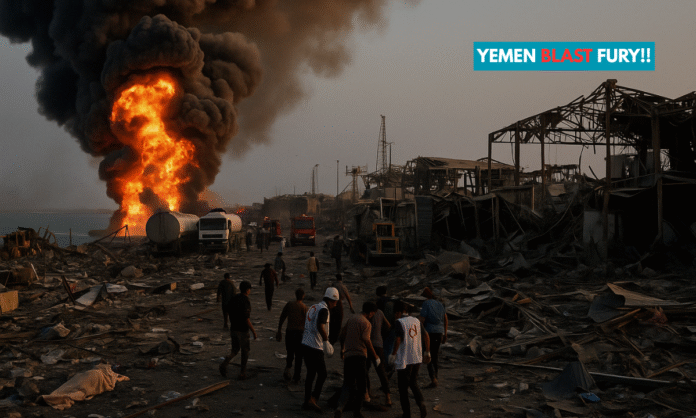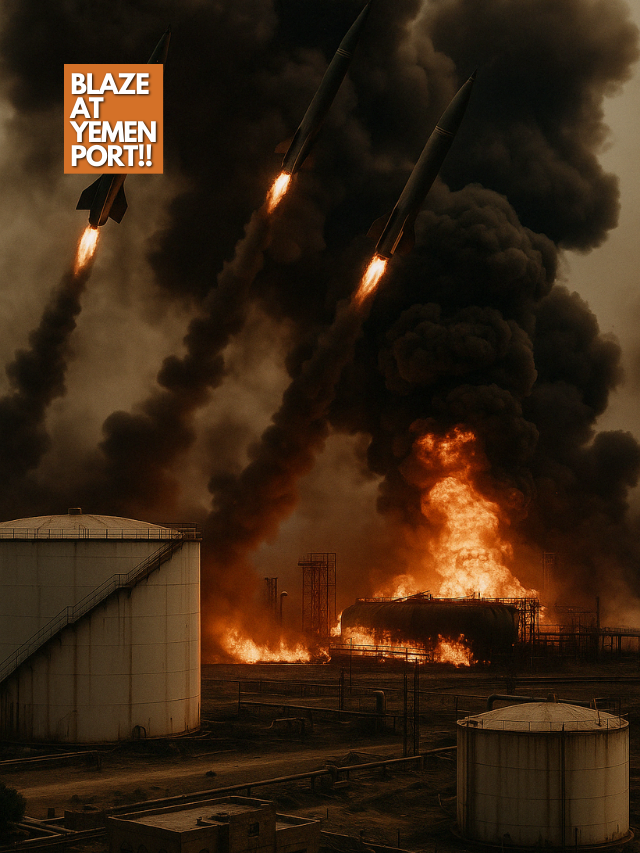Summary
- At least 80 killed and 150 wounded in US airstrikes on Yemen’s Ras Isa oil port, per Houthi officials.
- CENTCOM says the target was a Houthi fuel hub used to fund terror operations.
- Strikes spark global outrage over civilian deaths and humanitarian fallout.
America’s Deadliest Strike in Yemen Since 2021: Civilian Death Toll Sparks Global Condemnation
In one of the most lethal US military actions in Yemen in recent years, airstrikes on the Ras Isa oil port killed at least 80 people and injured over 150, according to Houthi officials. The victims included port workers, truck drivers, and emergency responders, in what Houthi spokespersons are calling a “war crime.” The US military’s Central Command (CENTCOM) has acknowledged the strikes, stating they were aimed at degrading the Houthis’ “economic source of power.”
The airstrikes on the Ras Isa oil port were launched on Thursday, but the death toll surged Friday evening as more bodies were pulled from the rubble. Video footage broadcast by the Houthi-run Al-Masirah TV showed horrifying scenes of charred vehicles, burning oil drums, and corpses lying amidst debris. Rescue efforts, already strained by conflict and resource scarcity, were further hampered by renewed threats of missile retaliation.
This strike comes amid a renewed wave of tensions in the Red Sea region, with the Houthis increasing their missile launches towards Israel and US naval assets in recent weeks. The humanitarian fallout is now growing, with 70% of Yemen’s imports and 80% of its aid dependent on this very port.
US bombing attacks on Yemen’s Ras Isa oil port have killed dozens of people, according to Houthi-affiliated media. The strikes are some of the deadliest since the US launched a bombing campaign on March 15. pic.twitter.com/rzE3rNPer5
— Al Jazeera English (@AJEnglish) April 18, 2025
Why Ras Isa Matters: Strategic Oil Lifeline or Terror Revenue Hub?
- Ras Isa hosts one of Yemen’s few functioning oil export terminals connected to the Marib-Ras Isa pipeline.
- The UN calls it “critical and irreplaceable infrastructure” for humanitarian access.
- CENTCOM claimed the site was used to fund “Iran-backed Houthi terrorist activities.”
While CENTCOM defended the strike as a counterterrorism measure, critics point to the staggering civilian toll and the timing, with tensions already high in the Middle East over Gaza. The oil terminal is not just a strategic target—it’s a lifeline. The port handles critical shipments of fuel and humanitarian goods for a country already facing famine-level hunger in some regions.
Al-Masirah TV reported that the first four bombs fell as workers were unloading trucks, suggesting no prior warning was given. Dozens of port workers are feared dead or severely injured. Houthi media outlets have since been publishing graphic videos and survivor testimonies, framing the strike as an act of colonial aggression meant to starve the Yemeni people into submission.
Houthis Respond: ‘This Will Not Go Unanswered’
- Houthis launched missile attacks on Israel and US aircraft carriers in retaliation.
- Houthi spokesperson Yahya Saree warned of “more confrontations and counter-attacks.”
- Protests erupted in Sanaa with chants against US and Israeli aggression.
The Houthi leadership has made it clear: this is far from over. Within hours of the Ras Isa strike, missiles were fired at Israeli targets and US warships. Though intercepted, these attacks underscore a broader escalation strategy. “The American military build-up and continued aggression… will only lead to more counter-attacks,” said Houthi military spokesperson Yahya Saree.
Thousands gathered in Sanaa to protest what they called “American-Israeli crimes”, carrying flags of Palestine and chanting slogans linking Gaza and Yemen’s shared struggle. The Houthi narrative is clear—they are fighting a unified warfront against Western imperialism in the Arab world.
This messaging has found some traction beyond Yemen, particularly in parts of Iraq, Lebanon, and Syria, where pro-Iran groups have echoed support. Meanwhile, Israel’s military confirmed the interception of missiles from Yemen, indicating a cross-border escalation is already underway.
Humanitarian Fallout: A Country on the Brink
- 80+ dead, 150+ injured, according to Hodeidah Health Office.
- Rescue teams and medics were also among casualties.
- UN agencies warn of “massive disruption” to food and fuel deliveries.
Yemen, already grappling with the world’s worst humanitarian crisis, now faces a new level of paralysis. The Ras Isa port is not just an oil export site—it’s a choke point for food, fuel, and medicine. Destroying it or rendering it non-operational risks cutting off millions of Yemenis from basic survival.
Humanitarian groups, including the Yemeni Red Crescent and the United Nations Development Programme, have warned that any sustained targeting of port infrastructure could trigger famine-level events in weeks. Relief workers on the ground said their teams were forced to pull out due to safety concerns, leaving behind injured survivors with no emergency care.
This also means aid convoys via Hodeidah and as-Salif, Yemen’s other key ports, could soon face similar threats, whether by targeted strikes or retaliatory blockades by Houthis.
A Widening War: US Tactics, Global Reactions
The Biden administration has yet to issue a detailed statement, but the airstrike signals a hardening of the US military stance in the Red Sea, particularly against Iranian proxies. The March airstrikes that killed over 50 were seen as a warning. The Ras Isa strike appears to be a direct attempt to cripple Houthi logistics—but at what cost?
Meanwhile, international reactions have begun to pour in. Several Gulf nations, though quietly allied with US objectives, have distanced themselves from the operation, especially after the civilian toll became clear. Iran, expectedly, has condemned the strikes and vowed “a regional response.”
Geopolitical analysts warn that this could become a multi-front conflict, with Yemen becoming a secondary battleground in the shadow war between the US, Israel, and Iran.
From Fuel to Firestorm: What Comes Next?
The Ras Isa strike may have succeeded in halting some fuel shipments—but it’s opened a Pandora’s box of retaliation, regional instability, and humanitarian collapse. Whether this was a one-off escalation or the start of a broader US offensive remains to be seen.
For now, the world watches as Yemen, already in ruins, inches closer to total collapse—and the line between “targeted strike” and “civilian massacre” grows ever thinner.



